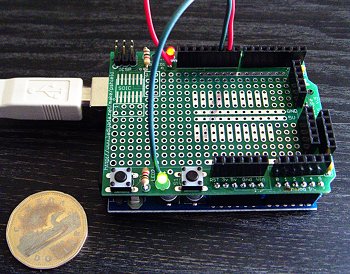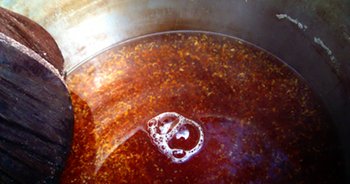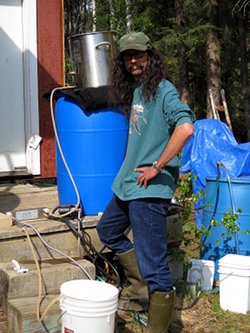
Arduino and prototyping shield
Yesterday, my Arduino board showed up in the mail. It’s pictured in the photo alongside a Canadian dollar from when I drove up to Alaska. I ordered it with a prototyping shield and Getting Started with Arduino, a book written by one of the developers of the Arduino platform. The book is a great introduction to the hardware and the software you use to control the gadget. To fully appreciate the book, you’ll want to get a few extra extra components so you can try the experiments in the book. These include a breadboard, solid core wire for the breadboard, a button, light sensor, LEDs, and a variety pack of resistors.
What is it? It’s a very simple computer connected to fourteen digital input / output pins, six analog input / output pins, and a USB communication system so you can read data and put programs on the system. In other words, you can read data from the environment, control things based on that data, and send data back to a computer all on the same small board. I’m interested in using the platform to build my own weather station to complement the professional station we have. But more generically what’s cool about it is that it provides an inexpensive (my board was $35) platform for “programming” the world. Instead of buying a gadget off the shelf that someone else has built to perform a task they think you’ll want, you can build something to do exactly what you want.
In the real world.
All I’ve done with it so far is to control the flashing of the pair of LEDs that came with the prototyping shield. I know that doesn’t sound very exciting, but if you can control LEDs and make them go on and off, or vary their intensity, that means you can control anything that takes an on / off, or variable input. For example, a set of fans in your house whose speed and direction is controlled by the relationship between the temperature in the house, in the attic, and outside. Or controlling a sprinkler system that senses how wet the ground is, reads the weather forecast from the Weather Service and only turns on the sprinklers if no rain is expected. Or a system that operates a dog door, sensing which dog has approached by reading an RFID tag on their collar and then opening or locking the door depending on whether they are allowed in or out.
You get the idea. Combining any of the wide variety of input sensors available with the ability to do things based on logic that you control is a really powerful tool. And the low cost of the board makes it reasonable to experiment and try things out until you get a system working the way you want.
My initial project will include a series of temperature sensors that I’ll put in different places in the house and outside (maybe even in a dog house?), a light sensor and a barometric pressure sensor. Of course, you can buy small weather stations that have all of these things in them, but most can’t read temperatures below -40°F, and most only have one sensor. Best of all, I’ll plug mine into a “real” computer via USB and record the data as it comes in.

Protein after the boil
Spent some of yesterday brewing a batch of Bavarian hefeweizen. It’s a light, easy drinking summer beer that preserves the unique flavors of the Bavarian wheat beer yeasts. Most American varieties of hefeweizen use a cleaner, less flavorful American yeast. My original version of this beer was named after the shed I build to house our water tank in the old house. Now that we’ve moved and have a new shed, the beer has been re-christened “New Shed Hefeweizen.”
The beer has six pounds of base malt—two pounds of 6-row and four pounds of 2-row organic pale malt in this case—and six pounds of malted wheat. Wheat malt contains a lot of protein, as does the 6-row malt. As I mentioned in my post about Piper’s Red Ale, protein causes haze in the final beer and can affect it’s long-term stability. In the case of a hefeweizen, the haze is a feature of the style, and because it’s a summer “session-style” beer, it’ll get consumed more quickly than a typical ale. So all the protein shouldn’t be a problem and will contribute to a nice thick head on the finished beer. You can see all the protein floating around in the wort (it’s the white stuff in the photo that looks like the eggs in egg-drop soup). Most of the big chunks get filtered out in the pot as the wort is chilled, but even with the gross removal, there’s still a lot left over in the fermenter.
My last batch of beer, Devil Dog turned into a comedy of errors. The mash and boil went perfectly, but when chilling I accidentally left the stopcock on my fermenting bucket open. Lost a couple gallons of wort into the snow. After fermentation was finished and it was in the keg, one of my new serving lines had a loose bolt on the keg connector. Not only did this cause all the remaining beer to leak out inside my kegerator (three gallons of it), but I completely drained my CO2 tank. So this time around, I paid very careful attention to everything I was doing.
The mash, boil, and chilling went well. Mashing a grain bill that’s 50% wheat is always a little nerve-wracking because wheat has no husks to help in filtration, and as anyone who had made bread by hand knows, wheat plus water equals a very sticky substance. My mill does a good job of preserving the barley husks, and I didn’t have any extraction issues when sparging. I wound up with an excess of wort, however, so I had to boil it quite a bit longer to get down to five gallons. The final beer might be a bit maltier as a result, because of the additional carmalization of the sugars in the pot. I bumped up the hops slightly in an attempt to offset this.
Chilling was a bit of an experiment. I pulled thirty gallons of water from Goldstream Creek and used that in a closed loop through my plate chiller to chill the wort. It’s in the blue barrel on the right side of the image. The temperature at the start was around 50°F, and that wasn’t quite cool enough to drain the kettle with the valve all the way open. But I got it down to a pitching temperature of 70°F, which is about right for a hefeweizen.
A true hefeweizen yeast is an interesting strain because you can control the flavors from the yeast by changing the fermentation temperature. Like Belgian beers, a Bavarian hefeweizen comes with lots of flavors that would be considered serious defects in a British (or worse, American) ale. At cooler temperatures (cooler than 65°F), you’ll get more banana flavors, and warmer fermentation encourages clove tones. I tend to prefer the banana flavor, but at lower temperatures you’re always risking a sluggish or incomplete fermentation. This time around, I’m hoping to keep fermentation closer to 68°F, which should yield a nice dry beer with a good balance of banana and clove flavors.
Assuming I don’t pump all the beer into my kegerator again, I should know how it turned out in four to six weeks.
I’d meant to recap our trip to Homer earlier this month, but never got around to it, so here it is (I’m waiting for the New Shed Hefeweizen mash to finish). We entered all our birds into the animals database winding up with a total of 53 species, including yellow-billed loons, which was a life-bird for both Andrea and me. We didn’t see any Red knots, which was a disappointment since they’re expected to go extinct within the next ten years. Last year we only saw one, but in past years we’ve seen groups of them. It’s shocking to witness the elimination of a species (OK, subspecies…) over such a short period of time.
Spring migration was well underway when we got back from Homer, and we’ve been keeping track of all the birds as they come into to our yard. We’re still twenty-one species shy of our total last year, but new birds are still showing up. This morning’s new species was a Swainson’s Thrush, which showed up one day earlier than last year.
It’s been an interesting 12 hours: seismic activity in Interior Alaska has really ramped up, causing a multitude of small quakes, and three large enough that we felt and heard them. Last night there was a magnitude 3.5 earthquake around 9 miles from our house, and this morning there have been two more (a 3.2 about 11 miles away and a 2.9 that was only 6 miles away). None caused any damage, but they do shake the house and make enough noise that the dogs perk up. Experiencing tectonic forces so large and powerful is a sobering (and exciting) experience.
There’s a general perception in the lower 48 that California is the most seismically active place around, but the huge subduction zone that stretches from the Aleutian Islands all the way to the west coast of North America causes earthquakes and volcanic activity all over Alaska. The 1964 Good Friday quake (pictured in the photo) was the largest ever recorded in North America, and the 2002 Denali earthquake (which we rode through at the Bird Observatory) was an order of magnitude larger than the 1989 Loma Prieta earthquake that ripped up the Bay Area during the World Series. Most of the major earthquakes are south of the Alaska Range where the plates are moving against each other closer to the surface, but all the pressure creates fault lines up here in Fairbanks and can trigger some fairly large events.
Our house is less than ten years old, but knowing it went through the Denali quake without incident allows us the luxury of appreciating the power of the geologic processes at work without worrying they’ll destroy our house.
Update: 31-May-2009, 21:35. Magnitude 3.8, eight miles away.

Homer panorama


